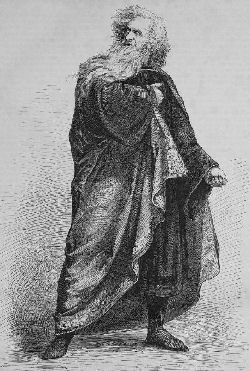The Anatomy of a Story
|
Way back in the 5th century b.c., Aristotle thought about what made a good story and decided it was a tale with a beginning, a middle and an end. Atistotle would have liked Shakespeare's King Lear: a King decides to divide his kingdom among his daughters before he dies, to avoid squabbling after his death (the beginning); civil war breaks out among the daughters because none are satisfied with what they've received (the middle); the old King and the warring daughters die, leaving in the hands of the good daughter the destroyed kingdom, which will now heal and regain prosperity (the end.) Now a beginning, middle and end may seem obvious, but you'd be surprised how many times we see videos that are just a mish-mash of shots, without a beginning, middle and end. Photo montages -- photographs compiled to commemorate an event such as a retirement, an award ceremony or the life of someone departed -- are often worse: a picture of Fred as a child, three pictures of Fred in high school, a picture of Fred as a baby and two photos of Fred's old car. You're thinking: "Hey! This video is about our trip to Disney Land. It's not Aristotle or Hollywood. There's no story here." But there is if you begin thinking in story terms, and your videos and montages will benefit from it. Here's an example from a video we saw not long ago that illustrates what I mean: Two young women graduated from college together and before one left to get married, they decided to take a trip across the United States. Their tapes contained typical tourist footage, with a couple of notable exceptions that made their trip tapes into a wonderful story and DVD. The first tape began with footage of the car, in front of their Sorority, piled high with all their clothing and picnic baskets for the trip. This was followed by shots of a sign that said "Boston." This was the beginning. Next came footage of the places they visited. To organize this they had a story-telling "gimmick" that worked admirably. Every time they entered a new State, one of the women, a cheerleader in college, posed in front of the State sign doing a gymnastic "split." All of this footage was the "middle" and the humorous introduction of the State signs kept the viewer aware of where they were in their travels. Finally, we saw the "Los Angeles" sign again, and watched as one of the women boarded a plane to begin another episode in her life. This completed the story. It didn't take much planning -- just thinking "story telling" -- "How do we deal with the start and finish of our trip, and how do we help people know where we are?" |
 Carl Grunert als König Lear, 1866 |
-
Photo Montages are greatly enhanced if you think in story telling terms. You're putting all these photos together to tell the story of someone's accomplishments or to share memories of their life. How to do this:
- Find a way to begin. This could be a picture of Fred as a baby, but it could as well be a picture of the house in which Fred grew up, followed by pictures of his mom and dad, older siblings and then Fred. Or it could be a photo of a newspaper or magazine from the month and year of Fred's birth. Or it could be a picture of Fred as last appeared, with a dissolve back to Fred as a baby -- a "flashback."
- You can tell the story chronologically, from birth to death, or from start to finish of the accomplishment.
- You can tell the story thematically, grouping interests and activities. Within these groupings you might further group chronologically -- i.e., Fred playing tennis from 7 years old until his death at 84; another section of Fred enjoying water sports as a child and as an adult; Fred cataloging his coin collection, etc.
- Use pictures with dates, signage, place names, etc., to establish time and location. Or, if that isn't possible, consider small easily read captions that help to establish where we are in the life story.
- Finally, find a way to conclude the story -- a picture of the finished building you're commemorating, a picture of Fred as you want him to be remembered.
- One of the most poignant endings we've ever seen was in a memorial tribute to a departed wife and mother.
She is in the middle distance of the photograph, on a country lane. Her back is to the camera. She has turned back toward the photographer, her face in profile, waving "Goodby." The country lane stretches out before her.
Organize, think "story," and you'll produce videos and photo montages that are entertaining, memorable and moving.

